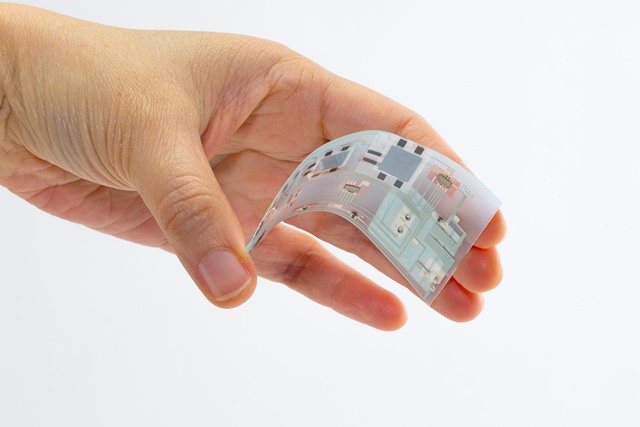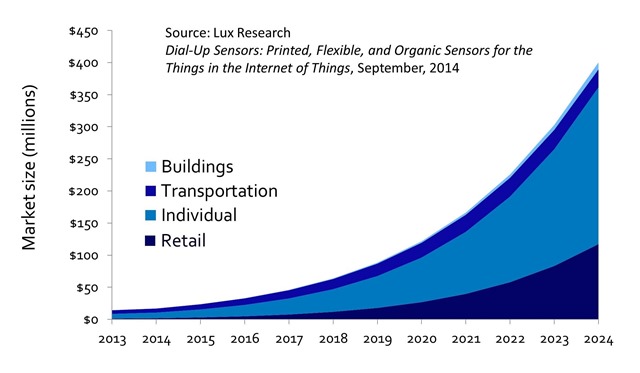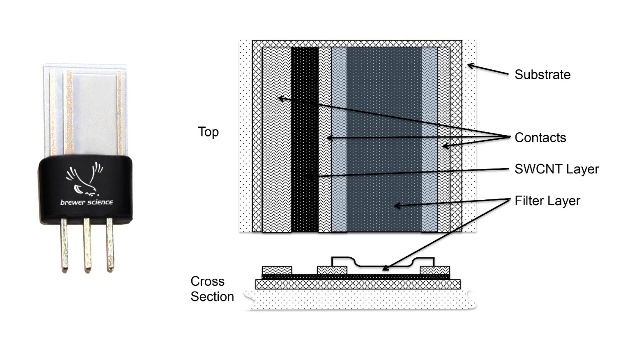By ROGER H. GRACE
President, Roger Grace Associates,

Fig. 1: Printable/flexible sensors offer new capabilities well suited to wearables and IoT. Shown is a temperature-sensing Smart Label from Thinfilm which uses technology from PST Sensors.
With wearables and Internet of Things (IoT) applications proliferating, potential suppliers want to develop printable/flexible (P/F) sensors (fig.1 ) that can fulfill these applications’ requirements in unique ways. Accordingly, Lux Research [1] expects the market for P/F sensors to grow from $17 million in 2014 to approximately $400 million by 2024 — a compounded annual growth rate of 35% (see fig.2 ).

Fig. 2: According to Lux Research, the market for P/F sensors is poised to grow very rapidly in a few years.
Roger Grace Associates believes this growth will be driven not by a technology push, but by market pull from many significant applications in sports/wellness/medical wearable devices. These applications will exploit several inherent features of P/F sensors, such as:
- Small size / low profile
- Low manufacturing cost based on existing batch-mode processing, with the ability to be scaled to ultra-high volume, roll-to-roll (R-2-R) manufacturing
- Enhanced performance over discrete 3-D solutions due to size and geometry
- Device-to-device uniformity
- Ability to conform to the surfaces to which they are attached
- Lower capital expenditures for manufacturing
- Ease of integration with other functions on the same or layered carriers
While several of these features are shared by existing microelectromechanical systems (MEMS), MEMS are typically not flexible, cannot be manufactured in an R-2-R process (batch-mode only), and can require significant capital investments (unless of course one uses a silicon foundry for wafer processing).
In order of announcement date, the following companies have brought P/F sensors to market: Interlink Electronics (www.iefsr.com), PST Sensors (www.pstsensors.com), Spec Sensors (www.specsensors.com), and Brewer Science (www.brewerscience.com). While by no means an exhaustive list of today’s P/F sensor suppliers, this group provides a solid survey of the types of sensors currently available.
Force and displacement sensing
P/F sensors became commercially available in 1985, with Interlink Electronics’ introduction of Force Sensing Resistor (FSR) technology. Interlink Electronics was a very early, if not the earliest, organization to successfully commercialize P/F sensors. In 1985 when the company was founded, it began developing its proprietary FSR technology which is still a key part of their wide sensor product line. Interlink has moved from its original sensor supplier position to a “human-to-machine solutions provider”. The company has been able to successfully satisfy customer application requirements by providing sensors and discrete microcontrollers with proprietary, application-specific algorithms as part of their solution.
Interlink’s FSR technology consists of a polymer, PET, or plastic substrate with its first functional layer being a proprietary, conductive-carbon-based patterned circuit configuration that serves as the sensor. A electronics network is printed on the underside of the next functional layer, which also serves as the encapsulant of the stack.
The Versa Pad is an excellent example of Interlink’s integration/systems solutions approach, which solves customer application requirements while simultaneously adding value to their product offering. This touch pad device uses FSR sensors along with discrete microprocessors that run proprietary algorithms to provide sensor fusion. Applications include computer mouse and touchpad pointing, hand-held consumer devices, and human-to-machine (HMI) interface touch solutions as well as analog data capture for machines.
Early in its commercialization of FSR, Interlink provided an FSR-based pad mounted in the front passenger seat of a car. The pad was used to determine the location of the passenger in the seat to enable the “smart” deployment of the air bag. Today, Interlink is delivering pressure-sensitive touch sensors for vehicle navigation panel control and door entry control. Albert Lu, Interlink’s CTO, notes that,” Our automotive touch-sensitive sensors are unique, in that they can work under tough conditions, such as when users have moist fingers or are wearing gloves, that others can’t. Ruggedized laptop computers manufactures have exploited this feature.”
Temperature and humidity sensing
Margit Harting and David Britton co-founded PST Sensors as a spin-off of their work on silicon nanoparticle- based electronics, which started in 2002 at the University of Cape Town, South Africa. Their work on P/F sensors began in 2010, the company was founded shortly afterwards, and their first thermistor was introduced in the spring of 2011. In September 2014, PST Sensors moved to its independent premises where they are continuing applications development and producing P/F temperature sensors. These sensors consists of silicon semiconductor and silver conductor patterns that are applied to substrates of paper and plastic (PET and other polymer) films using a silk-screen printing process. [2]
According to Britton, “Our printable/flexible temperature sensors … have a well-known response to temperature. They perform better than discrete components because of their low thermal mass, and better thermal contact [which gives them] a faster response time of under a second, compared to 5 to 10s for discrete thermistors. Additionally, since our technology is scalable, we can easily create large-area thin sensors, enabling higher sensitivity than discrete components. The variable form factor, ability to integrate with any other electronics technology, and an extended temperature range of −267°C to above 100°C make them available for a wide range of applications.”
A major current application of their temperature sensor is in the Smart Label (fig. 1 ) from Thinfilm (www.thinfilm.no) where the sensor is integrated with other functions realized with printed electronics — including memory, logic, and readout —to measure the condition of packaged goods in transit or in storage. Applications include measuring the thermal conditions of pharmaceuticals in transit, and food freshness validation and spoilage determination.
Brewer Science is a new entrant into the P/F sensor world, leveraging its 30 years’ experience in specialty materials for semiconductor industries to develop a fully integrated temperature and humidity sensor, the TH1022A101 transducer (fig. 3 ). Employing Brewer Science’s proprietary, highly purified, electronics-grade aqueous SWCNT ink, the sensor is capable of providing real-time simultaneous measurement of temperature and rapidly fluctuating humidity in the surrounding environment. Its ultrahigh-speed sensing capability positions it among the fastest sensors of its kind in the world: it senses within 10 ms, which is fast enough to read the fluctuations in humidity due to someone speaking!

Fig. 3: Brewer Science employs it proprietary, highly purified, electronics-grade aqueous SWCNT ink to create the TH1022A101 temperature-humidity transducer.
According to Robert Frueh, Brewer Science’s Director of New Business Development, “Brewer Science’s system integration capabilities allow it to go well beyond just providing sensors. It is able to fully integrate sensors with hardware and software configurations to network a full array of sensors across a wide area – all in a wireless fashion – while capturing the data in real time for the use.”
There is also some noteworthy work going on with printed gas sensors. See sidebar, A printed, non-flexing sensor for electrochemical gas sensing
Future developments
Although few companies are currently offering commercial P/F-based sensors at this time, there’s a great deal of research at several universities and institutes. Key centers of this activity include Fraunhofer EMFT (www.emft.fauunhofer.de/en.html) [3, 4] , and Fraunhofer ENAS (www.enas.fraunhofer.de/en.html)the Imec Holst Centre (www.holstcentre.com), Northeastern University’s High-rate Nanomanufacturing Center (www.nano.neu.edu) [5], and the UC San Diego Jacobs School of Engineering Center for Wearable Sensors (www.jacobsschool.ucsd.edu/wearablesensors/) [6, 7], VTT (www.vtt.fi).
TO LEARN MORE…
If you’d like to learn more about P/F sensor activity , Roger Grace Associates will present papers on the topic at the upcoming MEPTEC MEMS Technology Symposium in San Jose. CA, on May 20 (www.meptec.com) and at the MEMS Industry Group Pre-Conference session at Sensors Expo 2015 on June 9 (www.sensorsexpo.com)
References
[1] Lux Research, Dial-Up Sensors: Printed, Flexible and Organic Sensors for the Things in the Internet of Things , September, 2014
[2] U. Manni et al., “Interfacial and Network Characteristics of Silicon Nanoparticle Layers Used in Printed Electronics,” Japanese Journal of Applied Physics , 52 (2013), 05DA11, pp. 1-3
[3] “Interflex – Interconnection technologies for flexible systems,” Fraunhofer Research Institution for Microsystems and Solid State Technologies EMFT
[4] K. Bock et al, “Multifunctional system integration in flexible substrates,” Proceedings of the 2014 IEEE 64th Electronic Components and Technology Conference , May 2014, pp.1482-1487
[5] A. Busnaina, “Nanoprinting Scales Up,” The Wired World, 2015, p.28
[6] R. Grace, “Why MEMS-based system solutions?,” Electronic Products , February, 2011, pp. 17-19
[7]A. Bandodkar et al., “Tattoo-Based Wearable Electrochemical Devices: A Review,” Electroanalysis 2015 , Wiley-VCH Verlag GmbH and Co., pp. 562-572
About the author
Roger H. Grace ()is president of Roger Grace Associates, a Naples Florida–based strategic marketing consulting firm specializing in high technology, which he founded in 1982. His background includes over 45 years in high-frequency analog circuit design, application engineering, project management, product marketing, and technology consulting. A pioneer in the field of MEMS, Mr. Grace has specialized in sensors and ICs for over 35 years, and his clients include the international “Who’s Who” of corporations, federal labs, and government agencies. He received his BSEE and MSEE (as a Raytheon Fellow) from Northeastern University and was its Engineering Alumni of the Year in 2004.
Advertisement
Learn more about Roger Grace Associates





